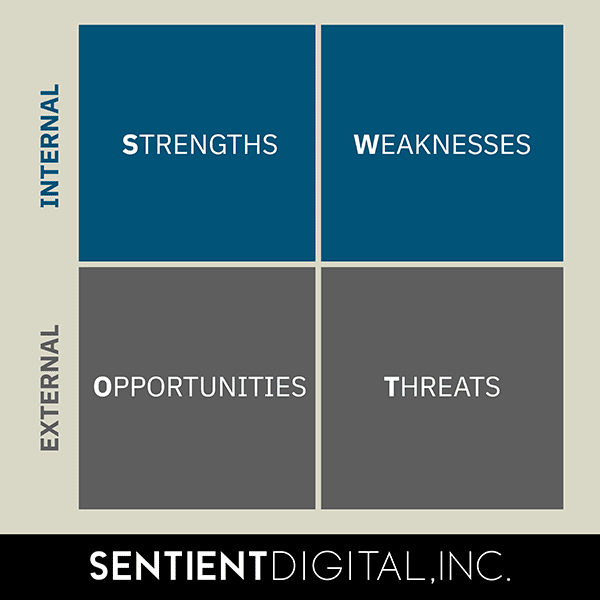Using SWOT analysis, digital transformation is guided by a foundational business analysis practice, putting it to work to integrate digital technology.
Begin by separating each of the four SWOT criteria (strengths, weaknesses, opportunities, and threats) into their respective internal and external facing positions. This is one of the primary methods that businesses fail to apply what they learn from their SWOT analysis. Grouping the categories in this way should assist you in determining what your next steps are.
One of the infamous drawbacks when a company performs a SWOT analysis is the lack of clarity in the implementation. Examining the internal and external SWOT categories separately, here are the best ways to apply SWOT analysis to digitally transform your business.

The Internal SWOT Categories
The internal SWOT analysis categories are strengths and weaknesses. These are internal because they are truly about your business itself. That means you have direct control over these things. To get a sense of the internal categories, you should ask for input from people at all levels of your company. Your employees on the ground, your executives, and everybody in between have helpful input to contribute if you take a moment to listen.
Strengths
It is helpful to think of your business strengths in two different ways. First, you can list all of your traditional strengths, including your assets, skills, or reputation. This list will serve as a baseline for how you view your business holistically. The mistake many businesses make is stopping with this general list of strengths. That is not always helpful because a compilation of general strengths will leave you with a picture of a general company, not the unique strengths of your particular company.
Your SWOT analysis should also include the strengths that set your business apart from the competition. If every company you are competing with has good facilities, it is an important strength to list, but you are not identifying the strengths that paint a picture of your unique selling position. This can make it more difficult to distill a course of action once you begin implementing the SWOT analysis digital transformation approach, so make sure you think of and include differentiating strengths.
How to Use Your Strengths for Digital Transformation
When employing a SWOT analysis, digital transformation essentially requires creating a more precise SWOT analysis tailored to your organization. Once you have compiled your strengths and identified the things that set you apart from the competition, you can begin conducting research on digital workflows that lean on your particular strengths.
For example, one of your strengths might be a customized technology or product your team has created that is not commercially available. Using your SWOT analysis to drive the digital transformation of your strengths could look like researching ways to bring your competitive advantage to the digital space. That might mean using modern technology to reduce friction, improve the user experience, or increase profitability.
Throughout the process of identifying your unique, competitive strengths, it’s important to remember that these strengths are internal. You have direct control over these things, and separating that from what you do not have control over will allow you to better narrow your next steps, after conducting the SWOT analysis.
Weaknesses
One of the difficulties that businesses face when thinking through their weaknesses is conflating this category with opportunities. This viewpoint is a problem because it makes applying the SWOT analysis more difficult.
Instead, defining each separately, and drawing a hard line between weaknesses and opportunities will allow you to better see your next steps. Weaknesses are the internal aspects of your company that are keeping it from performing at its true potential. Remember that weaknesses are internal, while opportunities are external. The internal weaknesses are things that are directly under your control. When your company is conducting its SWOT analysis, use this question as the litmus test: What is under our internal control and what is under the influence of external factors or circumstances?
How to Use Your Weaknesses for SWOT Analysis Digital Transformation Optimization
Once your SWOT analysis has been conducted, ask yourself another essential question: How are your weaknesses making your digital transformation more difficult? For example, has your company migrated to the cloud? If not, that could be a key digital weakness that is barring your company from moving other workflows to the digital space.
As with strengths, reviewing your original SWOT analysis for weaknesses is helpful when making the transition to applying it to your digital transformation. By doing this, you will walk away with a concise list of exactly the things you need to make your digital transformation happen.

The External Categories
The two external SWOT categories, opportunities and threats, allow you to make normative judgements about how your business will adapt and shift with outside influences. These are not directly under the control of your business, so you will have to capitalize on or manage the risk associated with various events based on your analysis.
Opportunities
Opportunities are those external factors that your company can capitalize on to propel the business ahead of the competition. These might include market shifts or trends. As an example, one of the major opportunities companies in the automotive industry are seeing is the implementation of electric vehicles. These companies have no direct control over whether the market adopts electric vehicles. However, a savvy automotive company may see this potential opportunity and be ready to capitalize on it should it arise.
This is a clear example of an area where the line between what is a weakness and what is an opportunity is blurred. Is it a weakness that your company does not have an electric vehicle when the market is gravitating in that direction, or is the demand for electric cars an opportunity that your company can capitalize on? In this case, it’s more helpful to categorize this problem as an opportunity because though a company might choose to create an electric vehicle, it is doing so as a result of the market, which is outside its direct control. Accounting for this slight nuance will make applying your SWOT analysis more straightforward.
How to Capitalize on Opportunities for Digital Transformation
To capitalize on opportunities as they relate to digital transformation, it may be helpful to first review your weaknesses and strengths, then compare them to your list of opportunities. Then, your company can select the key opportunities in a digital transformation that would allow you to gain an advantage over your competitors.
Your strongest opportunities are the ones that allow your business to leverage its strengths. In the case of digital transformation, you might consider how market trends could align with a product or service you have created. How might capitalizing on new technologies allow your business to look ahead and be prepared for future opportunities?
Threats
Threats are the external factors that could negatively impact your ability to do business. A natural disaster, increased governmental regulation, or your competitor receiving a key patent are all external threats that could disadvantage your business. Doing additional research to identify opportunities and threats is essential to a thorough SWOT analysis.
Threats inform risk management, so threats are one of the key categories where quantitative data can be very important. This is often a great investment of time and resources because it will continue to inform your risk management efforts as your business grows and the market changes.
How to Reduce the Risk of Threats to Digital Transformation
Applying your list of threats to your digital transformation requires looking at external factors and thinking through how they might inhibit your ability to undertake a digital transformation. If your budget is already being stretched to implement the software needed for a digital transformation, what would it mean if your software providers decided to increase rates? On the other hand, cybersecurity transformation is becoming increasingly important, and your security is an additional factor to consider when thinking about threats to your digital transformation.
Consider Outsourcing Your SWOT Analysis Digital Transformation Process
Conducting a good SWOT analysis can be very time consuming, but applying it specifically to your digital transformation is another layer of difficulty. Especially if your company does not have the technological capabilities needed to conduct a full-scale digital transformation, this step might be more difficult than you anticipated. Because of this, many businesses will outsource this step to technology companies, who can use their expertise to create a technology roadmap for their digital transformation.
After that first step of conducting the SWOT analysis, companies face many obstacles when it comes to mapping the path forward to digitally transform their business. At Sentient Digital, Inc., we use our expertise to drive the adoption and scaling of digital and technological initiatives.
That means your business will not only be digitally transformed, but it will grow with you as your business changes and adapts. Scalability is one of the factors that companies may neglect to adequately build into their plans, but we make sure your systems can handle your growth, so you do not have to reimplement another digital transformation in five years.
Contact Sentient Digital, Inc. for analysis and a plan for your digital transformation needs.




